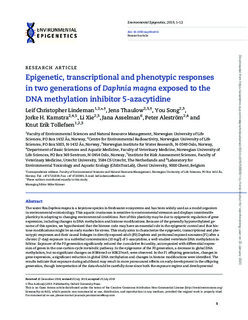Epigenetic, transcriptional and phenotypic responses in two generations of Daphnia magna exposed to the DNA methylation inhibitor 5-Azacytidine
Lindeman, Leif Christopher; Thaulow, Jens; Song, You; Kamstra, Jorke H; Xie, Li; Asselman, Jana; Alestrøm, Peter; Tollefsen, Knut-Erik
Journal article, Peer reviewed
Published version
Permanent lenke
http://hdl.handle.net/11250/2637575Utgivelsesdato
2019Metadata
Vis full innførselSamlinger
- Publikasjoner fra Cristin - NIVA [2149]
- Scientific publications [1172]
Sammendrag
The water flea Daphnia magna is a keystone species in freshwater ecosystems and has been widely used as a model organism in environmental ecotoxicology. This aquatic crustacean is sensitive to environmental stressors and displays considerable plasticity in adapting to changing environmental conditions. Part of this plasticity may be due to epigenetic regulation of gene expression, including changes to DNA methylation and histone modifications. Because of the generally hypomethylated genome of this species, we hypothesized that the histone code may have an essential role in the epigenetic control and that histone modifications might be an early marker for stress. This study aims to characterize the epigenetic, transcriptional and phenotypic responses and their causal linkages in directly exposed adult (F0) Daphnia and peritoneal exposed neonates (F1) after a chronic (7-day) exposure to a sublethal concentration (10 mg/l) of 5-azacytidine, a well-studied vertebrate DNA methylation inhibitor. Exposure of the F0 generation significantly reduced the cumulative fecundity, accompanied with differential expression of genes in the one-carbon-cycle metabolic pathway. In the epigenome of the F0 generation, a decrease in global DNA methylation, but no significant changes on H3K4me3 or H3K27me3, were observed. In the F1 offspring generation, changes in gene expression, a significant reduction in global DNA methylation and changes in histone modifications were identified. The results indicate that exposure during adulthood may result in more pronounced effects on early development in the offspring generation, though interpretation of the data should be carefully done since both the exposure regime and developmental period is different in the two generations examined. The obtained results improve our understanding of crustacean epigenetics and the tools developed may promote use of epigenetic markers in hazard assessment of environmental stressors.

